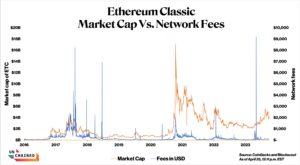When a public company falters and is delisted to the penny stock arena, trading grinds to a halt and its valuation plummets as stockholders cut their losses and move on.
Equities trade upon a set of near-universal fundamentals that take the rise and fall of their company’s fortunes into account. A cadre of blockchains, however, demonstrate that crypto loyalists have been playing by different rules. And what they’re worth may have more in common with putting a price on a Chanel purse or an Hermès scarf.
Referred to as “zombie blockchains,” these networks have minimal developer activity, few active wallet addresses, little transaction demand, or a combination of all three, yet are able to maintain massive valuations.
The reasons appear to be a combination of their intangible qualities, longevity in surviving multiple crypto cycles, and the presence of loyal adherents avidly promoting their favored networks.
Suki Yang, CEO of Solana trading platform xBot, told Unchained that “cryptocurrencies, arguably, are the most successful and the only asset class that really capitalizes on intangible values.”
Those intangible elements include community and culture, as well as a common and perhaps unconventional belief about what a token is worth — plus outside perceptions of engagement around a network. They add up to play a significant role in the valuations held by crypto zombies.
Yang, who’s also a data scientist at crypto-focused venture firm Electric Capital, compared the crypto industry to the fashion industry in this respect.
In the fashion world, brands derive their worth partly from the tangible: the quality of a bag, the clarity of a gemstone, or the weight of a fabric. But their value also stems from intangible characteristics: the brand’s social status, history, and storytelling ability.
People don’t spend thousands of dollars on Chanel or Hermès solely based on the exclusivity or quality of leather, according to Yang.
“It’s because of the intangible value of what does [the product] say about me when I carry that bag,” Yang said.
Like high-fashion fanatics, token holders don’t just think about their cryptocurrencies from a quantitative, utility perspective, but instead consider intangible values as part of overall investment considerations, Yang said.
What Makes a Zombie Blockchain
Forbes recently classified 20 blockchains as zombies based on the fact that they had valuations of more than a billion dollars “despite the fact that they are unproven and have little utility other than for speculative crypto trading.”
Those 20 blockchains had a collective market capitalization of more than $100 billion, representing about 4.7% of the current market cap of all cryptocurrencies of about $2.4 trillion.
Forbes specifically named the following networks as crypto zombies: XRP (XRP), Cardano (ADA), Bitcoin Cash (BCH), Litecoin (LTC), Internet Computer (ICP), Ethereum Classic (ETC), Stellar (XLM), Stacks (STX), Kaspa (KAS), Fantom (FTM), Monero (XMR), Arweave (AR), Algorand (ALGO), Flow (FLOW), MultiversX (EGLD), Bitcoin SV (BSV), Mina (MINA), Tezos (XTZ), Theta (THETA), and EOS (EOS).
Representatives for 15 of those blockchains did not return Unchained’s requests for comment.
While Forbes’ list of zombie blockchains mostly “made sense,” Nate Crowningshield, public relations manager for Kaspa, told Unchained that Kaspa’s inclusion didn’t. According to Crowningshield, zombies imply death, and Kaspa is still a young network that only rolled out in November 2022.
Kaspa, which commands a $3 billion market cap, has roughly 30 contributing developers, Crowningshield said. By contrast, Optimism, which had 574 developers in the past week according to blockchain analytics firm Artemis, has a market cap of $2.6 billion.
However, Crowningshield said Kaspa’s value is derived from the network’s technology of peer-to-peer digital cash, as well as future prospects of smart contract functionality and a consensus overhaul that would replace current coding language Go with the more widely used Rust.
Ethereum Classic (ETC), which forked from Ethereum in 2015, is another example of a zombie chain cited by Forbes. It’s the fifth largest proof-of-work chain by market cap with a figure of $3.9 billion, listed on many exchanges, and recently recorded 24-hour trading volumes north of $200 million. And yet, Ethereum Classic had just three developers and 24 GitHub commits in the past week, data from Artemis highlights. And blockchain explorer Blockscout shows that between April 17-23, Ethereum Classic had a total of just 14.992 ETC in transaction fees, or roughly $390.

But Bob Summerwill, executive director of the ETC Cooperative, which supports and promotes the network, denied that Ethereum Classic is a zombie. “The value proposition of most of these ‘zombie chains’ is broader than just transactions per second or whatever other metric you care to mention… ETC is small, but it is not a ‘zombie,’” Summerwill told Unchained via X.
He added that it is not like many other venture capital-backed chains, which have “vast funding, huge TVL, media campaigns, and ecosystem grants programs.”
Litecoin Foundation’s director of communications, Jay Milla, also rejected the idea that Litecoin is a zombie in an email to Unchained, pointing to Glassnode data out how Litecoin’s network activity exceeded that of Bitcoin’s multiple times in the past year.
The notion that Algorand is a zombie is “completely insane,” according to Marc Vanlerberghe, Algorand Foundation’s chief marketing officer. Vanlerberghe pointed to the increase in new addresses, as well as the number of developer initiatives in the network’s ecosystem, such as a meetup on May 16 and a dev retreat, called Decipher, which both take place in Barcelona.
“Our strategy from an engineering perspective has always been: Let’s go meet the developers where they are and give them the tools that they’ve already used,” Vanlerberghe told Unchained.
Vanlerberghe expects the number of developers to increase, following the rollout of AlgoKit 2.0 last month, which enabled coders to write Python applications on Algorand.
The ‘Lindy Effect’
Paradoxically, the zombie chains that have been limping along the longest, may be the most likely to continue soldiering on. Consider that Litecoin, launched in 2011 and now the oldest in the category of zombie chains, has a market cap of $6.2 billion but a total value locked of just $5.16 million.
The longevity phenomenon may be explained by what’s known as the “Lindy effect,” which defines the life expectancies of things such as technologies or ideas. Essentially, systems with long histories are more likely to have longer futures ahead than newer creations. That’s in part because new iterations of existing products face steeper competition to catch on.
Surviving just one or two crypto cycles, as has Bitcoin Cash, which debuted in 2017 as a Bitcoin fork, can make all the difference — leading to “a ton of Lindy effect, even when people are not necessarily using that much of your product or your chain,” xBot’s Yang said, adding that longevity “creates a ton of value.”
Despite having a market cap of close to $10 billion, Bitcoin Cash had just 17 developers in the past week, per Artemis, and $49,225 in total network fees for all of 2023.
The Role of Whales, Founders, and Gamblers
Another reason for zombie blockchains’ continuing high valuations is that large token holders continue to pump them.
Jim Hwang, chief operating officer of crypto investment firm Firinne Capital, told Unchained in a text message that “social media, shilling by founders and loyal adherents, etc. are keeping prices above their intrinsic values.”
This unmooring from intrinsic value may tie back to the launch of the blockchains, with convention creating allocations for “substantial portions of the total circulating supply to their founding teams,” according to Sam Callahan, a senior analyst at Swan Bitcoin.
“This means the actual circulating supply is much smaller than advertised, allowing these founding teams to easily manipulate the price of their illiquid tokens upwards, enriching themselves and artificially inflating their blockchain’s market cap,” Callahan said.
In addition, when significant token holders start to sell, the thinly traded markets may tank the token price. As a result, it is in the best interest of whales and founders not to dump all at once, which helps keep valuations high. “They are in the business of making sure that prices don’t fall too much,” Yang said.
Of course, some token holders don’t care about fundamentals and blockchain technology, marking “a disease among the speculators in this industry,” wrote Andrew Smith, founder of blockchain scaling startup Versatus, over Telegram. Some trade because “they care about increasing their fiat bags, so this is effectively a mechanism to gamble without going to a casino,” Smith added.
However, since crypto zombies have nothing, Yang postulated that “bad news” doesn’t really apply to zombies. Yang pointed to Litecoin as an example. With zero fundamentals and no working product, Litecoin can’t really be hacked. Plus, LTC is “definitely not a security, because it doesn’t do anything,” according to Yang.
“When you think about it, it’s not going to zero at this point, right?” Yang said. “[When] you’ve got no fundamentals, people can’t fault you for shit.”
UPDATE (April 26, 2024, 5:46 p.m. EST): Adds comment from Algorand Foundation’s chief marketing officer.



